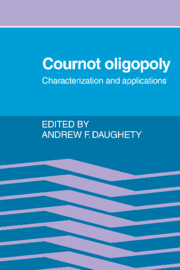Book contents
- Frontmatter
- Contents
- Preface
- Part I Introduction
- Part II Background
- Part III Examining Cournot's model
- Part IV Applications
- 12 Cournot and Walras equilibrium
- 13 Duopoly information equilibrium: Cournot and Bertrand
- 14 Information transmission – Cournot and Bertrand equilibria
- 15 Uncertainty resolution, private information aggregation, and the Cournot competitive limit
- 16 Losses from horizontal merger: the effects of an exogenous change in industry structure on Cournot–Nash equilibrium
- 17 Delegation and the theory of the firm
- 18 A study of cartel stability: the Joint Executive Committee, 1880–1886
16 - Losses from horizontal merger: the effects of an exogenous change in industry structure on Cournot–Nash equilibrium
Published online by Cambridge University Press: 07 September 2009
- Frontmatter
- Contents
- Preface
- Part I Introduction
- Part II Background
- Part III Examining Cournot's model
- Part IV Applications
- 12 Cournot and Walras equilibrium
- 13 Duopoly information equilibrium: Cournot and Bertrand
- 14 Information transmission – Cournot and Bertrand equilibria
- 15 Uncertainty resolution, private information aggregation, and the Cournot competitive limit
- 16 Losses from horizontal merger: the effects of an exogenous change in industry structure on Cournot–Nash equilibrium
- 17 Delegation and the theory of the firm
- 18 A study of cartel stability: the Joint Executive Committee, 1880–1886
Summary
The consequences of a horizontal merger are typically studied by treating the merger as an exogenous change in market structure that displaces the initial Cournot equilibrium. In the new equilibrium the merged firm is assumed to behave like a multiplant Cournot player engaged in a noncooperative game against other sellers. The purpose of this article is to evaluate an unnoticed comparative-static implication of this approach: some exogenous mergers may reduce the endogenous joint profits of the firms that are assumed to collude. Cournot's original example is used to illustrate this and other bizarre results that can occur in the Cournot framework if the market structure is treated as exogenous.
Introduction
In the Cournot [1838] solution to the oligopoly problem, each firm's output choice is profit-maximizing given the outputs of the other firms. The Cournot approach is conventionally extended to industries with merged firms and cartels by treating each merged entity as a collective of plants under the control of a particular player in a noncooperative game. The payoff to each coalition is the sum of the profits that accrue to each of its members. For each exogenous specification of market structure (partition of plants into coalitions), outputs, profits, and market prices are endogenously determined.
The purpose of this article is to explore and evaluate an unnoticed comparative-static implication of such Cournot models: some exogenous mergers may reduce the endogenous joint profits of the firms that are assumed to collude.
- Type
- Chapter
- Information
- Cournot OligopolyCharacterization and Applications, pp. 373 - 388Publisher: Cambridge University PressPrint publication year: 1989
- 82
- Cited by



